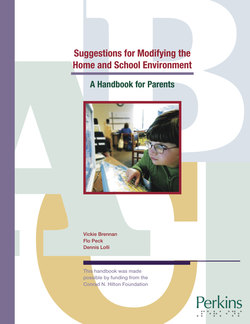Suggestions for Modifying the Home and School Environment: A Handbook for Parents

Реклама. ООО «ЛитРес», ИНН: 7719571260.
Оглавление
Dennis Lolli. Suggestions for Modifying the Home and School Environment: A Handbook for Parents
I. Introduction
Lighting
Color and Contrast
Size and Distance
Time
II. General Considerations for Working with a Child with Visual and Multiple Impairments
III. Indoor Considerations for Home and Educational Programs. General Suggestions
Classroom Suggestions. Organization
Illumination
Selection and Adaptation of Materials
IV. Outdoor Considerations
General Suggestions
Outdoor Environmental Factors. Illumination
Color and Contrast
Size and Distance
Angle of Viewing
Rate of Movement
Visual Clutter
V. Integrating Low Vision Suggestions into the Child's Communication System
Object Calendar Box/Shelf System
Organization
Objects
Two-Dimensional Representations of the Objects
Photographs
Tracings
Abstract Symbols
Sign Language
References
Отрывок из книги
This handbook has been designed for parents and teachers of children with dual sensory impairments and other physical limitations. It contains practical, affordable and easily implemented suggestions for enhancing a child's learning and mobility by making the environment more visible.
A child's environment—home, school program, and the community—plays an important role in how well the child is able to see and make use of his/her remaining vision. It is frequently assumed by parents, teachers and doctors that if a child does not benefit from glasses, optical devices or medical treatment nothing can be done to enhance a child's use of vision. The physical needs of the child with multiple impairments, as well as the needs of other children in the class, may overwhelm the parent or teacher preventing them from making simple modifications to the home or classroom. A child's use of functional vision can be greatly enhanced through observation of the child and experimentation with the environment, combined with knowledge of the visual disorder and how vision is affected.
.....
The quantity, type, direction, and position of illumination are critical to a child's visual performance. Some children are light-sensitive and may experience pain and discomfort from bright or direct light or glare. Other children need additional lighting to see optimally.
It is important to observe a child in a variety of lighting situations and to experiment with different light sources. Gooseneck lamps can be directed on the task and positioned to avoid glare. Desk lamps with rheostat controls can vary the amount of illumination. The distance between the light and the work surface will determine the amount of illumination. Many children with visual impairments prefer incandescent lighting or fluorescent lights without the blue spectrum. Work with the child to help him/her to position the lamp independently. Natural light should be used whenever possible. Facing into direct sources of light should avoided.
.....